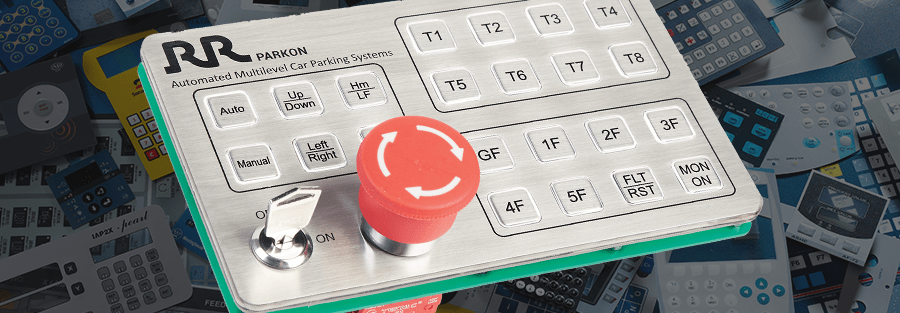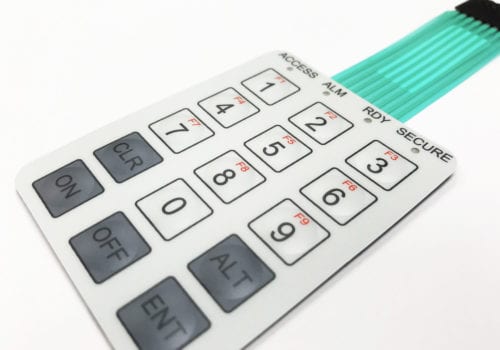Membrane Switches Over Explained: A Comprehensive Guide to Their Benefits
Membrane switches stand for a versatile and innovative remedy for developing individual interfaces throughout a selection of fields. As industries significantly look for trustworthy and reliable control interfaces, recognizing the details advantages and applications of membrane changes ends up being important.
What Are Membrane Layer Buttons?

When stress is used to the membrane layer switch, the layers make call, completing an electrical circuit. This straightforward device permits a variety of applications, from customer electronic devices to industrial machinery. Membrane buttons are usually designed to be waterproof and resistant to dust and pollutants, making them ideal for settings where sturdiness is vital.
Furthermore, the flexibility of the products made use of in membrane layer switches facilitates cutting-edge designs that can conform to numerous shapes and measurements. This adaptability adds to their popularity in varied fields, including clinical devices, automotive controls, and home devices. On the whole, membrane layer switches over represent a vital component in modern customer interface technology, linking the void between customers and electronic systems.
Trick Benefits of Membrane Layer Buttons
Among the myriad of interface choices available, membrane layer switches stick out for their special combination of advantages. Among the key benefits is their lightweight and small style, which permits for integration right into a large variety of tools without including considerable mass. This is specifically useful in applications where area is limited.
In addition, membrane switches deal durability and resistance to ecological elements. They are generally created with products that can endure dampness, dust, and numerous chemicals, making them appropriate for harsh problems. This toughness adds to a longer life-span compared to typical mechanical switches.
An additional significant benefit is the flexibility in modification. Membrane buttons can be printed with different graphics, shades, and structures, permitting for tailored layouts that meet details branding or practical requirements. This adaptability includes the variety of layers and circuit choices, giving designers with multiple configurations.
Moreover, the responsive feedback given by some membrane switches improves customer experience, making them much more instinctive to operate. The ease of cleansing and maintenance better solidifies membrane layer buttons as a useful option in both customer and industrial applications. Generally, these vital benefits make them a recommended solution for many designers and producers
Applications in Different Industries
Just how do membrane layer buttons find their place across diverse markets? Their versatility and functionality make them important parts in fields varying from healthcare to consumer electronic devices. In clinical tools, membrane switches are made use of for their ease of cleansing and resistance to contamination, ensuring hygiene in settings where sterility is important.
In the consumer electronics sector, these buttons supply smooth, easy to use interfaces that enhance item aesthetics while keeping durability versus deterioration. Automotive applications take advantage of membrane switches over also, where they are utilized in dashboards and control panels, supplying trusted efficiency in challenging problems.
Furthermore, industrial equipment utilizes membrane buttons for control board due to their robustness, capacity to stand up to severe settings, and adjustable designs that cater to specific functional requirements. The food industry leverages membrane layer buttons for their ease of use and resistance to spills, ensuring operational performance in busy setups.
Eventually, the versatility of membrane layer switches over throughout these diverse applications underscores their crucial role in modern-day technology, enhancing user communication while satisfying industry-specific demands. Their proceeded advancement promises further integration into emerging fields and innovative items.
Design and Personalization Choices
The design and customization choices readily available for membrane switches are critical for tailoring user interfaces to meet certain user demands and aesthetic choices. These buttons can be created in various forms, sizes, and layouts, permitting smooth assimilation into diverse applications. The flexibility in design suggests that manufacturers can produce distinct user interfaces that boost functionality and preserve brand identification.
Customized textures, graphics, and shades can be applied to the surface area of the membrane button, offering a possibility for branding and user interaction. In addition, backlighting choices, such as LED lighting, can be incorporated to boost presence in low-light problems, therefore boosting functionality.
Functional components can additionally be personalized, including tactile comments and actuation pressure, which can be adapted to match different user communications. The choice of materials, such as polyester or polycarbonate, enables variants in resilience and environmental resistance, satisfying the certain demands of various markets.
Eventually, the extensive design and personalization capabilities of membrane layer buttons enable companies to develop straightforward and aesthetically appealing user interfaces, making sure that their products meet both practical and visual demands effectively. Membrane Switches.
Factors To Consider for Execution
Applying membrane layer click reference switches over requires careful consideration of numerous aspects to ensure optimum functionality and customer experience. One of the key considerations is the desired application environment. Factors such as exposure to wetness, severe temperature levels, and chemical substances can dramatically hop over to these guys affect the button's performance and longevity. Selecting products that hold up against these problems is important.

An additional vital facet is the switch's style and format. Making certain that the responsive feedback and actuation force straighten with user expectations enhances use. Carrying out user screening can offer important insights into the optimal style.
In addition, compatibility with digital parts need to be evaluated. The switch's wiring must line up with the overall system style, guaranteeing trustworthy signal transmission and reducing interference.
Furthermore, production methods and costs need click now to be assessed. The choice between custom-made styles and common versions can lead and affect both budget plan time.
Finally, consider repair and maintenance. Membrane buttons might require details cleansing and treatment procedures to keep their look and capability with time. By attending to these considerations, companies can apply membrane layer switches that fulfill their functional requirements while providing a favorable user experience.

Conclusion
In conclusion, membrane layer changes stand for a sturdy and flexible control user interface appropriate for a large range of applications throughout multiple sectors. Membrane Switches. As innovation proceeds to advance, the importance of membrane layer switches in modern devices continues to be significant, supplying both functionality and visual charm.
Membrane switches represent a versatile and sophisticated remedy for producing individual interfaces throughout a range of sectors.Recognizing the fundamental components of modern-day electronic user interfaces, membrane layer buttons are a kind of customer interface gadget that are composed of flexible, slim layers of product. On the whole, membrane switches represent an essential element in contemporary user interface modern technology, connecting the void in between users and electronic systems.
Among the myriad of individual interface options available, membrane layer switches over stand out for their one-of-a-kind combination of benefits.The style and personalization alternatives available for membrane layer switches are critical for customizing interfaces to meet details user requirements and visual choices.